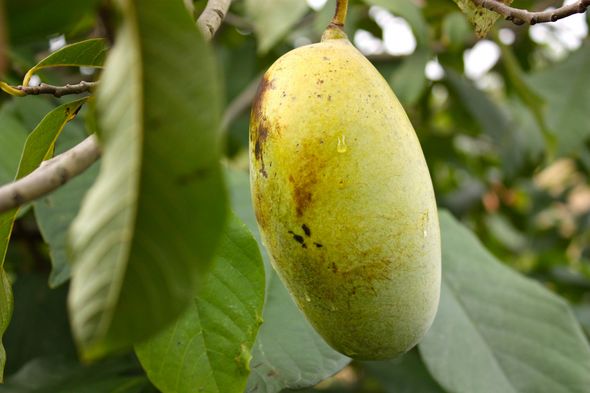Pawpaws are a fleeting autumn gift, so don't miss this unique Michigan fruit while it's in season

Pawpaws are heavy and thin-skinned, they fall from the tree when they are ripe. The custardy flesh ranges in color from white to pale orange.
Don't blink — it's pawpaw season. The only tropical fruit native to Michigan, pawpaws are so perishable and their season (usually in October in our area) is so short that it's rare to find them, even at a farmers' market.
Slow Food USA lists them among the Place Based Foods at Risk in the Great Lakes. And Zingermans' Ari Weinzweig calls them "the American fruit you've never tried." So I was surprised to hear NPR talking about pawpaws, America's forgotten fruit, last weekend. And even more surprised to find myself with a windfall of pawpaws from a local enthusiast.
Heavy and thin-skinned, pawpaws grow in bunches of up to nine fruits and fall off the tree when they are ripe. In fact, one harvesting technique is to shake the tree so that any ripe fruits will come loose and tumble down. It was a windy day when we were in the pawpaw patch, and you could hear them coming down with a "whump".
Pawpaws are also known as the: "False banana, pawpaw apple, custard apple, custard banana, poor man’s banana, banana tree, Indiana banana, Nebraska banana, Hoosier banana, Michigan banana, and as the white plum."
A ripe pawpaw is sweet and delicious, soft and custardy like a banana. I think they are best when you find one under a tree, break it open and eat it outdoors, spitting out the seeds. At home and civilized, I cut pawpaws in half and scoop out the sweet creamy flesh with a spoon. They definitely taste of banana, but a good one also has some mango, and maybe a little pineapple or caramel too.
In the olde-timey cookbooks, the only pawpaw reference I could find was for making preserves in Miss Parloa's New Cookbook of 1882. She says "The large white plums must be skinned by using boiling water, as for peaches, then throwing them into cold water. For one pound of fruit allow half a pound of sugar, and half a pint of water for three pounds of sugar. Cook but few at a time, and take them out carefully. Fill up the jar with hot syrup."
More modern recipes say that you can substitute pawpaw in almost any recipe calling for banana.
According to the Christian Science Monitor: "The forgotten pawpaw was first spread throughout the mid-Atlantic and westward by native Americans as a source of nutrition as the nomadic tribes pursued wild game, historians say."
A fruit tree nursery website describes how pawpaw fruits and trees were used by native Americans: "The fruit, which is the largest edible fruit native to America, is high in amino acids. The Iroquois used the mashed fruit to make small cakes that were dried and stored. The dried cakes were soaked in water and cooked to make a sauce or relish that was served with corn bread. Raw and cooked fruits were dried by the sun or on a fire. These were stored for use in the future or taken on hunts. The Cherokee used the inner bark to make cordage. By twisting the bark, they made string and strong ropes."
More recently, pawpaws have been studied for their natural insecticide and potential cancer fighting properties. Apparently, the only animal that likes eating pawpaw leaves is the zebra swallowtail butterfly — trace chemicals from the pawpaw leaves make the butterfly undesirable to birds and other predators.
While Ohio is the home of the Pawpaw Festival,Kentucky State University is a main center of research, and the home of the Pawpaw Foundation.
Pawpaw season is almost over here in Michigan. Though I still haven't seen them at the farmers' market, I bet there are some out there. Lots of people are starting to grow pawpaw trees as an interesting understory tree in their yards — there are even a couple behind the Grad Library on the U-M campus.
The nuances of flavor and texture are certainly best in a fresh pawpaw — they are worth seeking out. But barring finding some in the woods or at the market, Zingerman's seasonal pawpaw gelato is really delicious too. It's made from 200 pounds of fresh, local pawpaws.
Kim Bayer is a freelance writer and culinary researcher. She would love any news about interesting local food and agriculture efforts. Email her at kimbayer at gmail dot com.

